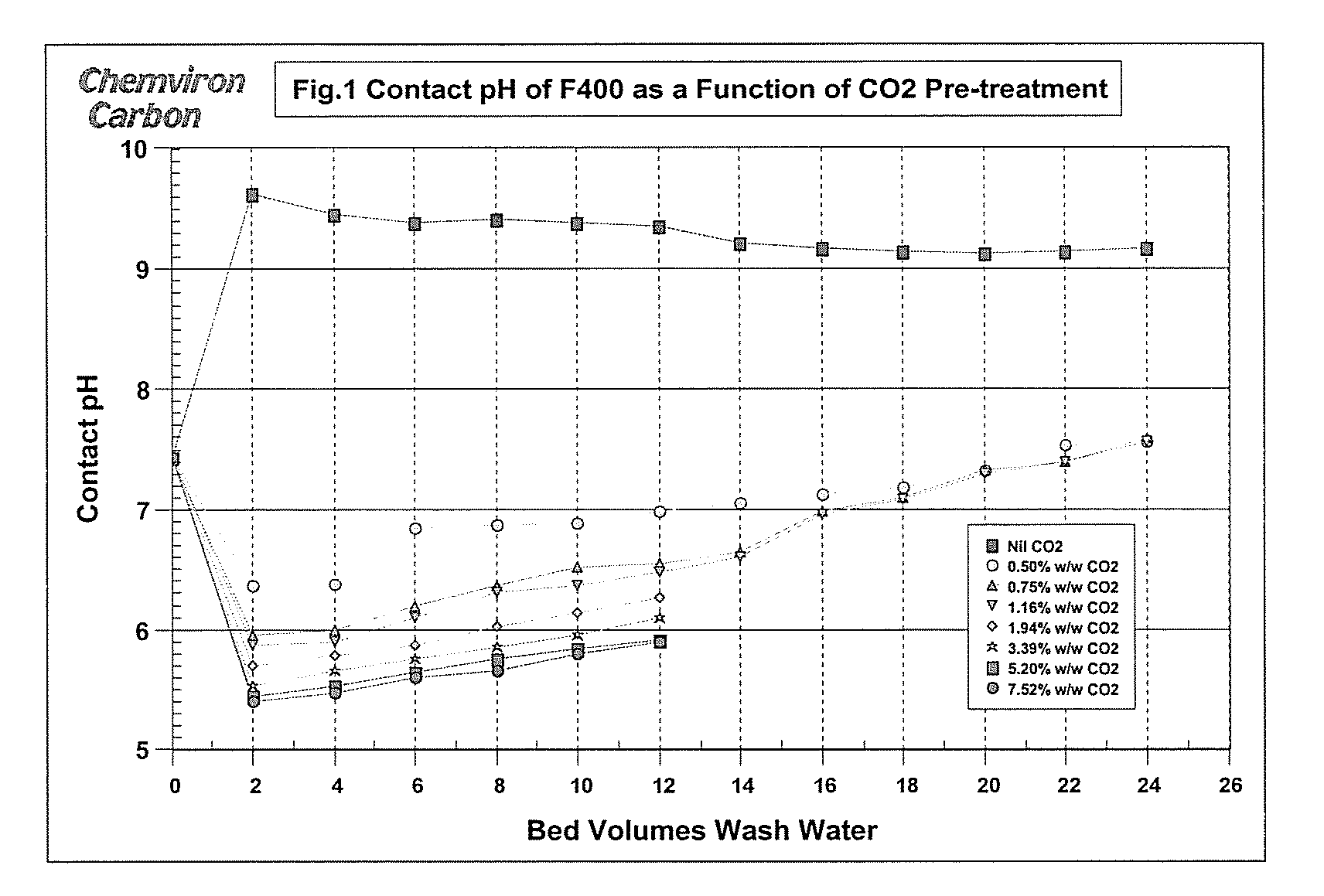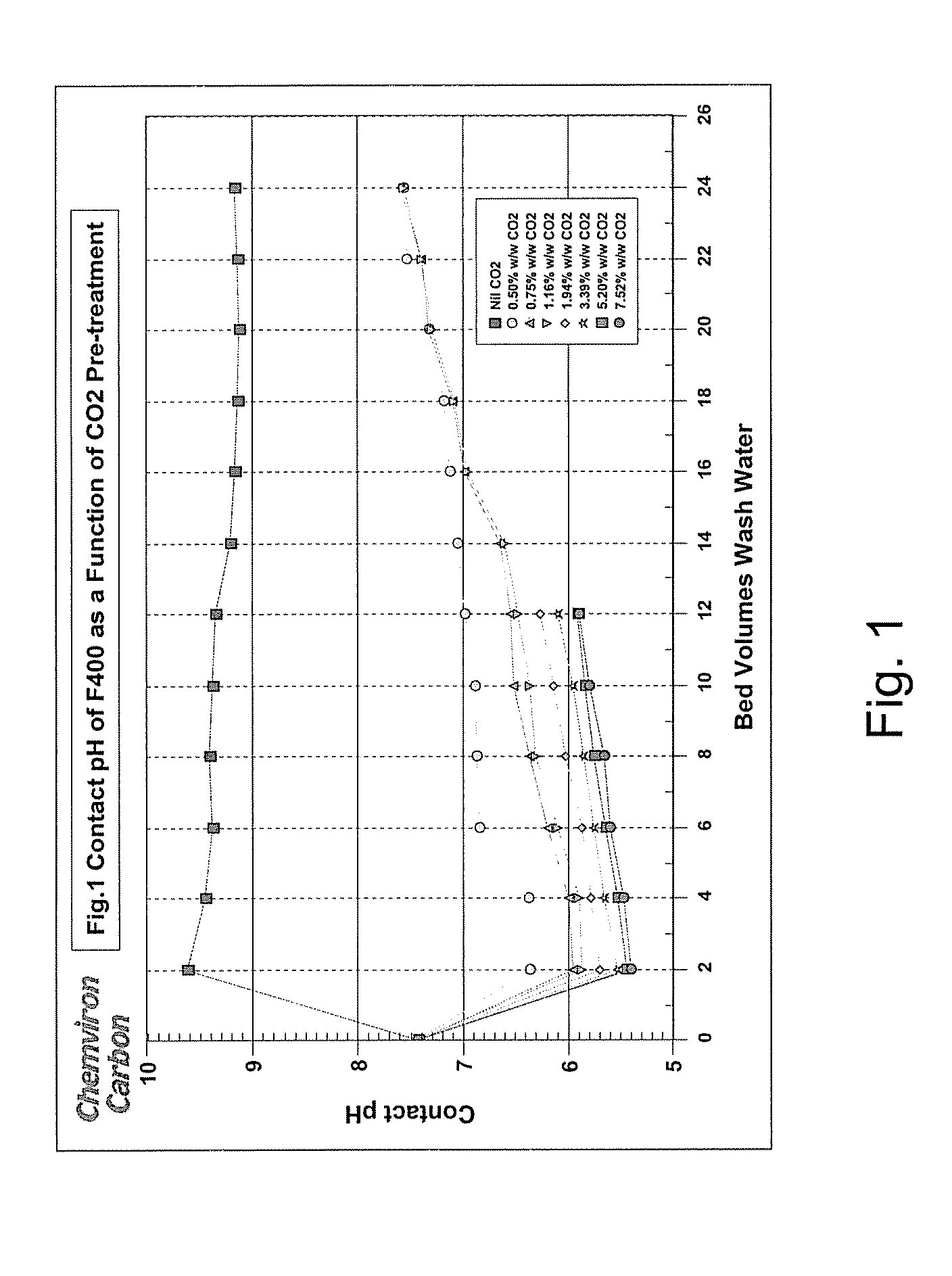Carbon pre-treatment for the stabilization of ph in water treatment
a technology of ph stabilization and pretreatment, which is applied in the direction of water/sewage treatment by neutralization, water treatment parameter control, chemistry apparatus and processes, etc., can solve the problems of not becoming part of common industrial practice, large quantities of high-ph water waste, and common use of methods, so as to reduce time, remove voluminous quantities of wasted water, and profound effect on the solubility of alumina
- Summary
- Abstract
- Description
- Claims
- Application Information
AI Technical Summary
Benefits of technology
Problems solved by technology
Method used
Image
Examples
example 1
[0024]Samples of untreated carbon and carbon treated as described above in amounts of 100 cm3 were added, in turn, to two bed volumes of water locally supplied by Ashton-in-Makerfield Township with stirring. The initial pH of the local water was 7.44. The contact pH was recorded after 30 minutes. The water was then decanted and two bed volumes of fresh Township water were added. This process was repeated a number of times to represent the effect of additional bed volumes. The contact pH was plotted as a function of the number of water bed volumes. Results are shown in FIG. 1.
[0025]All experiments were conducted at the laboratory ambient temperature and pressure. The laboratory bed volume measured 200 cubic centimetres (i.e. two bed volumes stated above).
Untreated Virgin Carbon
[0026]Addition of two bed volumes of the town's water to untreated F400 activated carbon resulted in the anticipated pH spike as illustrated in FIG. 1. The pH of the water was 7.44 but rose to 9.62 when added t...
example 2
[0035]Activated carbon (as received F400 carbon) was treated by exposing it to a flow of carbon dioxide gas to give a loading of 0.4% weight carbon dioxide by weight of the carbon. A loading of 0.4% carbon dioxide was pre-selected based on anticipated condition similarities with the prior example. A sample of treated carbon was used to contact raw feed waters from Nutwell Water Treatment Works (Yorkshire Water). For comparison, a sample of untreated carbon was also contacted with the feed water. Each sample contacted water contained in a laboratory bed column measuring 200 cubic centimetres. A notional contact time of 45 minutes was used. The pH of each treated effluent was measured at one bed-volume intervals over 30 bed volumes. Results of the two samples show a comparison of the effluent pH property of F400 carbon both with and without CO2 pre-treatment as illustrated in FIG. 6.
example 3
[0036]Additional samples of untreated carbon and carbon treated as described in Example 2, and contacted with water from the Haisthorpe Water Treatment Works (Yorkshire water). Results of water treatment with the carbon samples are illustrated in FIG. 7.
[0037]Neither of the Nutwell or Haisthorpe waters tested appeared to be particularly troublesome, indicating that only a minimal number of washes would be required during commissioning to bring the pH of the water to within the potable range. Nevertheless, treatment of the Filtrasorb 400 carbon with 0.4% w / w carbon dioxide gas produced effective nullification of the initial pH spike for both water samples, which were immediately measured to be within the potable limits, indicated by the dotted lines in FIGS. 6 and 7.
PUM
| Property | Measurement | Unit |
|---|---|---|
| volume | aaaaa | aaaaa |
| pH | aaaaa | aaaaa |
| weight | aaaaa | aaaaa |
Abstract
Description
Claims
Application Information
 Login to View More
Login to View More - R&D
- Intellectual Property
- Life Sciences
- Materials
- Tech Scout
- Unparalleled Data Quality
- Higher Quality Content
- 60% Fewer Hallucinations
Browse by: Latest US Patents, China's latest patents, Technical Efficacy Thesaurus, Application Domain, Technology Topic, Popular Technical Reports.
© 2025 PatSnap. All rights reserved.Legal|Privacy policy|Modern Slavery Act Transparency Statement|Sitemap|About US| Contact US: help@patsnap.com



